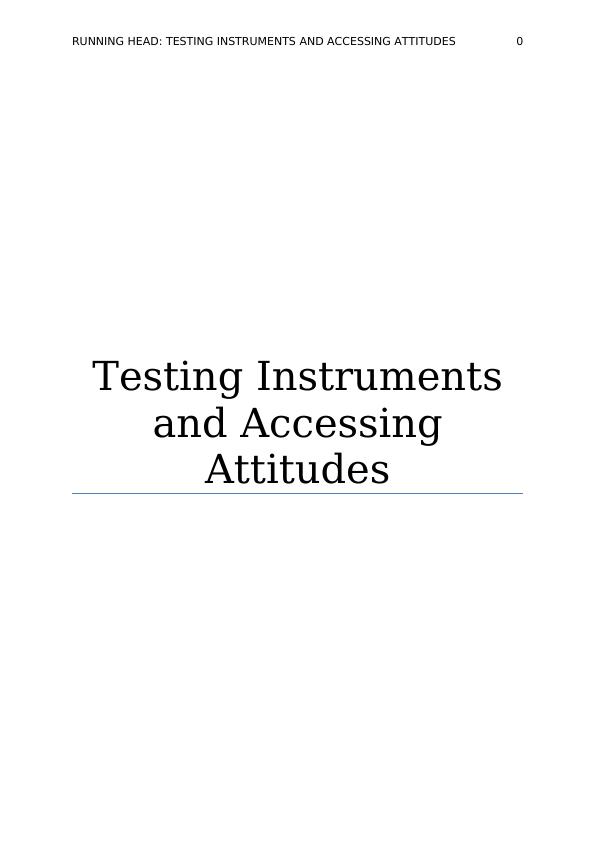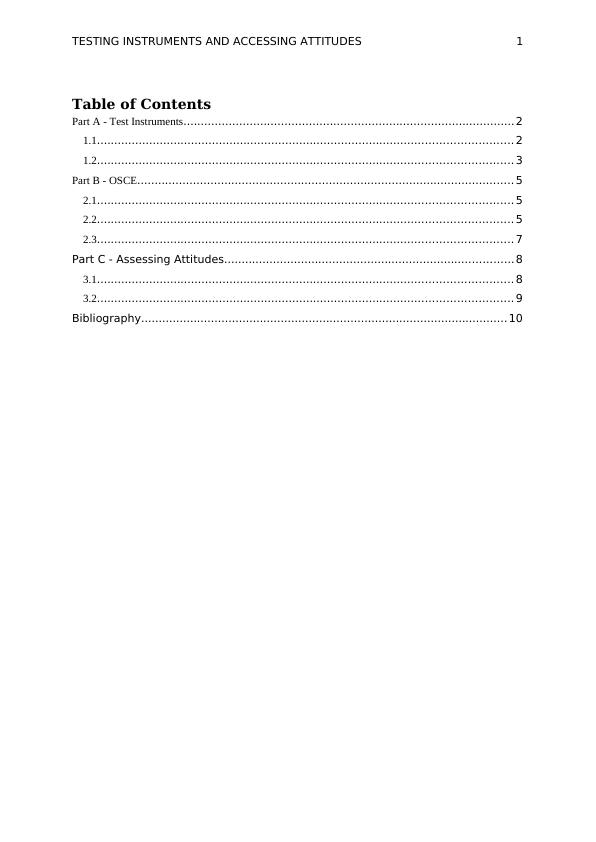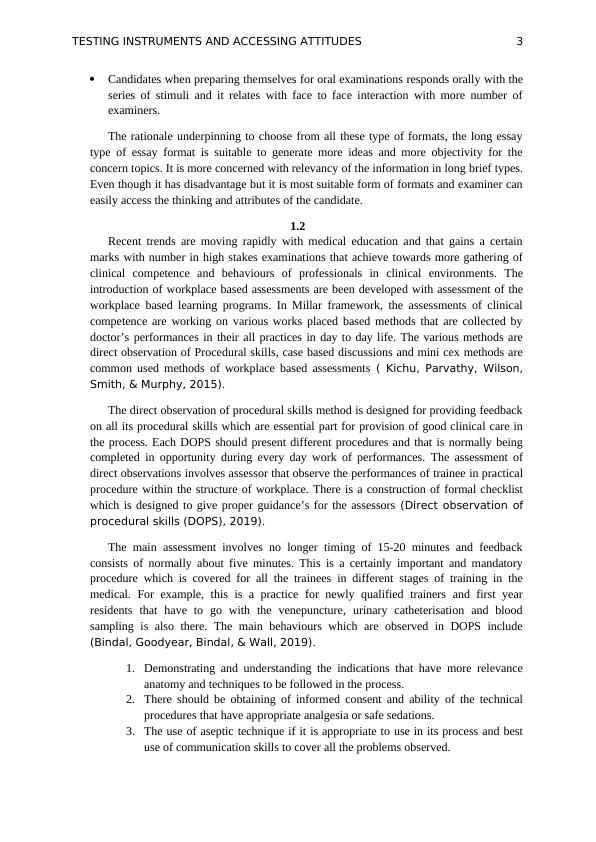TESTING INSTRUMENTS AND ACCESSING ATTITUDES 4. : TESTING
Identify the circumstances in which you would choose to use the long essay format, MCQs, and oral examinations as the most suitable methods. Share the rationale underpinning your choices informed by concepts.
14 Pages5654 Words2 Views
Added on 2022-11-11
TESTING INSTRUMENTS AND ACCESSING ATTITUDES 4. : TESTING
Identify the circumstances in which you would choose to use the long essay format, MCQs, and oral examinations as the most suitable methods. Share the rationale underpinning your choices informed by concepts.
Added on 2022-11-11
ShareRelated Documents
RUNNING HEAD: TESTING INSTRUMENTS AND ACCESSING ATTITUDES 0
Testing Instruments
and Accessing
Attitudes
Testing Instruments
and Accessing
Attitudes

TESTING INSTRUMENTS AND ACCESSING ATTITUDES 1
Table of Contents
Part A - Test Instruments............................................................................................... 2
1.1....................................................................................................................... 2
1.2....................................................................................................................... 3
Part B - OSCE............................................................................................................ 5
2.1....................................................................................................................... 5
2.2....................................................................................................................... 5
2.3....................................................................................................................... 7
Part C - Assessing Attitudes................................................................................... 8
3.1....................................................................................................................... 8
3.2....................................................................................................................... 9
Bibliography......................................................................................................... 10
Table of Contents
Part A - Test Instruments............................................................................................... 2
1.1....................................................................................................................... 2
1.2....................................................................................................................... 3
Part B - OSCE............................................................................................................ 5
2.1....................................................................................................................... 5
2.2....................................................................................................................... 5
2.3....................................................................................................................... 7
Part C - Assessing Attitudes................................................................................... 8
3.1....................................................................................................................... 8
3.2....................................................................................................................... 9
Bibliography......................................................................................................... 10

TESTING INSTRUMENTS AND ACCESSING ATTITUDES 2
Part A - Test Instruments
1.1
Developing the required skills and testing of different types of comprehensive
knowledge of cognitive skills is the main motive of medical students that leads to problem
based learning. These are different types of tools and techniques which relates to long essay
formative questions, conducting oral examinations and multiple type of questions that are
designed to test these skills. The main goal of the exam is accurately to evaluate the learning
of the students. The literature tends to favour MCQ questions as these are less reliable when
they are guess but these are easy way to calculate the results as well as easy to answers
(Beullens, Struyf, & Damme, 2019). The time needs to answer multiple choice questions
is very less. So, when there are more question in a paper it will designed to answer more
questions in number of questions.
In some places, it is suggested that guessing the answers should be discouraged
because when there is guessing it is least partial on student knowledge with relevant courses
of the content. The main weakness of all the stated essay questions by many authors is that
this requires grading of the subjects and those results in various unrelated factors of answers
that are impacting exam scores. Lukhele et al. examines that all the essay questions become
helpful as when measure with their learning’s, if students were allotted to select the variant of
long essay type of questions in whichever topic they have learned. Students learn differently
and deeply in preparing their long essay type questions which are access by higher level of
cognitive processing’s (Poetker, 2019).
The main disadvantages of essay type questions is that it uses less and it is most time
consuming method and used less in medical schools. There is problem of reliability and it is
most traditional way that relates to the long type of essay questions. It is difficult to be more
consistent in its scoring when this is to be access. Each essay question is being prepared with
lots of care and then it goes for testing for its reliability. In extended responsive questions, it
allows the candidates to write what facts they think are best suitable and their opinion to
choose the required formats. However, Grounlund states that restricted responsive questions
are less effective when other have to integrate ideas, select which is the unique purpose to
conclude in the essay test (Ornstein, 2019).
Oral examinations is an assessment tool used to evaluate in all the levels of surgical
trainings and this goes in term from student to board eligible surgeons. They provide rich
opportunities for its testing and it is most important part of clinical practices. To identify all
the testing competencies as critical thinking, communications and decisiveness are not well
addressed in other assessment tools of its operations. This provides improving in the
efficiency and subjectivity to minimise the rich assessment tools. The main advantages of
oral examinations are (Hill, 2016).
This is the simplest common procedure where one person is asking the relevant
question and other is speaking to it. Board that are used in oral examinations differs
they favour with less structure.
Part A - Test Instruments
1.1
Developing the required skills and testing of different types of comprehensive
knowledge of cognitive skills is the main motive of medical students that leads to problem
based learning. These are different types of tools and techniques which relates to long essay
formative questions, conducting oral examinations and multiple type of questions that are
designed to test these skills. The main goal of the exam is accurately to evaluate the learning
of the students. The literature tends to favour MCQ questions as these are less reliable when
they are guess but these are easy way to calculate the results as well as easy to answers
(Beullens, Struyf, & Damme, 2019). The time needs to answer multiple choice questions
is very less. So, when there are more question in a paper it will designed to answer more
questions in number of questions.
In some places, it is suggested that guessing the answers should be discouraged
because when there is guessing it is least partial on student knowledge with relevant courses
of the content. The main weakness of all the stated essay questions by many authors is that
this requires grading of the subjects and those results in various unrelated factors of answers
that are impacting exam scores. Lukhele et al. examines that all the essay questions become
helpful as when measure with their learning’s, if students were allotted to select the variant of
long essay type of questions in whichever topic they have learned. Students learn differently
and deeply in preparing their long essay type questions which are access by higher level of
cognitive processing’s (Poetker, 2019).
The main disadvantages of essay type questions is that it uses less and it is most time
consuming method and used less in medical schools. There is problem of reliability and it is
most traditional way that relates to the long type of essay questions. It is difficult to be more
consistent in its scoring when this is to be access. Each essay question is being prepared with
lots of care and then it goes for testing for its reliability. In extended responsive questions, it
allows the candidates to write what facts they think are best suitable and their opinion to
choose the required formats. However, Grounlund states that restricted responsive questions
are less effective when other have to integrate ideas, select which is the unique purpose to
conclude in the essay test (Ornstein, 2019).
Oral examinations is an assessment tool used to evaluate in all the levels of surgical
trainings and this goes in term from student to board eligible surgeons. They provide rich
opportunities for its testing and it is most important part of clinical practices. To identify all
the testing competencies as critical thinking, communications and decisiveness are not well
addressed in other assessment tools of its operations. This provides improving in the
efficiency and subjectivity to minimise the rich assessment tools. The main advantages of
oral examinations are (Hill, 2016).
This is the simplest common procedure where one person is asking the relevant
question and other is speaking to it. Board that are used in oral examinations differs
they favour with less structure.

TESTING INSTRUMENTS AND ACCESSING ATTITUDES 3
Candidates when preparing themselves for oral examinations responds orally with the
series of stimuli and it relates with face to face interaction with more number of
examiners.
The rationale underpinning to choose from all these type of formats, the long essay
type of essay format is suitable to generate more ideas and more objectivity for the
concern topics. It is more concerned with relevancy of the information in long brief types.
Even though it has disadvantage but it is most suitable form of formats and examiner can
easily access the thinking and attributes of the candidate.
1.2
Recent trends are moving rapidly with medical education and that gains a certain
marks with number in high stakes examinations that achieve towards more gathering of
clinical competence and behaviours of professionals in clinical environments. The
introduction of workplace based assessments are been developed with assessment of the
workplace based learning programs. In Millar framework, the assessments of clinical
competence are working on various works placed based methods that are collected by
doctor’s performances in their all practices in day to day life. The various methods are
direct observation of Procedural skills, case based discussions and mini cex methods are
common used methods of workplace based assessments ( Kichu, Parvathy, Wilson,
Smith, & Murphy, 2015).
The direct observation of procedural skills method is designed for providing feedback
on all its procedural skills which are essential part for provision of good clinical care in
the process. Each DOPS should present different procedures and that is normally being
completed in opportunity during every day work of performances. The assessment of
direct observations involves assessor that observe the performances of trainee in practical
procedure within the structure of workplace. There is a construction of formal checklist
which is designed to give proper guidance’s for the assessors (Direct observation of
procedural skills (DOPS), 2019).
The main assessment involves no longer timing of 15-20 minutes and feedback
consists of normally about five minutes. This is a certainly important and mandatory
procedure which is covered for all the trainees in different stages of training in the
medical. For example, this is a practice for newly qualified trainers and first year
residents that have to go with the venepuncture, urinary catheterisation and blood
sampling is also there. The main behaviours which are observed in DOPS include
(Bindal, Goodyear, Bindal, & Wall, 2019).
1. Demonstrating and understanding the indications that have more relevance
anatomy and techniques to be followed in the process.
2. There should be obtaining of informed consent and ability of the technical
procedures that have appropriate analgesia or safe sedations.
3. The use of aseptic technique if it is appropriate to use in its process and best
use of communication skills to cover all the problems observed.
Candidates when preparing themselves for oral examinations responds orally with the
series of stimuli and it relates with face to face interaction with more number of
examiners.
The rationale underpinning to choose from all these type of formats, the long essay
type of essay format is suitable to generate more ideas and more objectivity for the
concern topics. It is more concerned with relevancy of the information in long brief types.
Even though it has disadvantage but it is most suitable form of formats and examiner can
easily access the thinking and attributes of the candidate.
1.2
Recent trends are moving rapidly with medical education and that gains a certain
marks with number in high stakes examinations that achieve towards more gathering of
clinical competence and behaviours of professionals in clinical environments. The
introduction of workplace based assessments are been developed with assessment of the
workplace based learning programs. In Millar framework, the assessments of clinical
competence are working on various works placed based methods that are collected by
doctor’s performances in their all practices in day to day life. The various methods are
direct observation of Procedural skills, case based discussions and mini cex methods are
common used methods of workplace based assessments ( Kichu, Parvathy, Wilson,
Smith, & Murphy, 2015).
The direct observation of procedural skills method is designed for providing feedback
on all its procedural skills which are essential part for provision of good clinical care in
the process. Each DOPS should present different procedures and that is normally being
completed in opportunity during every day work of performances. The assessment of
direct observations involves assessor that observe the performances of trainee in practical
procedure within the structure of workplace. There is a construction of formal checklist
which is designed to give proper guidance’s for the assessors (Direct observation of
procedural skills (DOPS), 2019).
The main assessment involves no longer timing of 15-20 minutes and feedback
consists of normally about five minutes. This is a certainly important and mandatory
procedure which is covered for all the trainees in different stages of training in the
medical. For example, this is a practice for newly qualified trainers and first year
residents that have to go with the venepuncture, urinary catheterisation and blood
sampling is also there. The main behaviours which are observed in DOPS include
(Bindal, Goodyear, Bindal, & Wall, 2019).
1. Demonstrating and understanding the indications that have more relevance
anatomy and techniques to be followed in the process.
2. There should be obtaining of informed consent and ability of the technical
procedures that have appropriate analgesia or safe sedations.
3. The use of aseptic technique if it is appropriate to use in its process and best
use of communication skills to cover all the problems observed.

End of preview
Want to access all the pages? Upload your documents or become a member.
Related Documents
School Psychology : Assessment and Testinglg...
|8
|2699
|40
TAEASS401 - Plan Assessment Activities and Processeslg...
|11
|2754
|171
